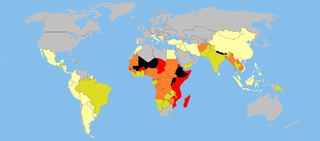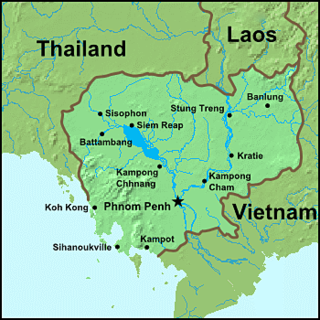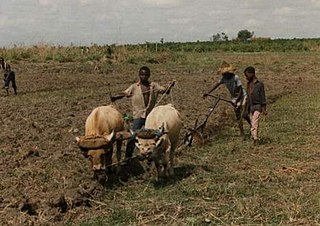
The International Labour Organization (ILO) is a United Nations agency whose mandate is to advance social and economic justice by setting international labour standards. Founded in October 1919 under the League of Nations, it is one of the first and oldest specialised agencies of the UN. The ILO has 187 member states: 186 out of 193 UN member states plus the Cook Islands. It is headquartered in Geneva, Switzerland, with around 40 field offices around the world, and employs some 3,381 staff across 107 nations, of whom 1,698 work in technical cooperation programmes and projects.

Child labour is the exploitation of children through any form of work that deprives them of their childhood, interferes with their ability to attend regular school, or is mentally, physically, socially and morally harmful. Such exploitation is prohibited by legislation worldwide, although these laws do not consider all work by children as child labour; exceptions include work by child artists, family duties, supervised training, and some forms of work undertaken by Amish children, as well as by Indigenous children in the Americas.

Trafficking of children is a form of human trafficking and is defined by the United Nations as the "recruitment, transportation, transfer, harboring, and/or receipt" kidnapping of a child for the purpose of slavery, forced labour, and exploitation. This definition is substantially wider than the same document's definition of "trafficking in persons". Children may also be trafficked for adoption.
Child labour in Botswana is defined as the exploitation of children through any form of work which is harmful to their physical, mental, social and moral development. Child labour in Botswana is characterised by the type of forced work at an associated age, as a result of reasons such as poverty and household-resource allocations. child labour in Botswana is not of higher percentage according to studies. The United States Department of Labor states that due to the gaps in the national frameworks, scarce economy, and lack of initiatives, “children in Botswana engage in the worst forms of child labour”. The International Labour Organization is a body of the United Nations which engages to develop labour policies and promote social justice issues. The International Labour Organization (ILO) in convention 138 states the minimum required age for employment to act as the method for "effective abolition of child labour" through establishing minimum age requirements and policies for countries when ratified. Botswana ratified the Minimum Age Convention in 1995, establishing a national policy allowing children at least fourteen-years old to work in specified conditions. Botswana further ratified the ILO's Worst Forms of Child Labour Convention, convention 182, in 2000.
The global march against child labour came about in 1998, following the significant response concerning the desire to end child labour. It was a grassroot movement that motivated many individuals and organizations to come together and fight against child labor and not an annual march.

Child labour in Bangladesh is significant, with 4.7 million children aged 5 to 14 in the work force in 2002-03. Out of the child labourers engaged in the work force, 83% are employed in rural areas and 17% are employed in urban areas. Child labour can be found in agriculture, poultry breeding, fish processing, the garment sector and the leather industry, as well as in shoe production. Children are involved in jute processing, the production of candles, soap and furniture. They work in the salt industry, the production of asbestos, bitumen, tiles and ship breaking.

A significant proportion of children in India are engaged in child labour. In 2011, the national census of India found that the total number of child labourers, aged [5–14], to be at 10.12 million, out of the total of 259.64 million children in that age group. The child labour problem is not unique to India; worldwide, about 217 million children work, many full-time.
The "Faces of Freedom" photo exhibition is a collection of photographs captured by photo-journalist, filmmaker and human rights educator U. Roberto (Robin) Romano, during his travels to India, Nepal and Pakistan. Romano explores the exploitation of child labor in the production of handmade rugs in coordination with multiple international organizations, such as the World Bank, UNICEF, International Labour Organization and others to reduce the number of child laborers in that industry. The exhibit has been shown in many United States cities since its first exhibit in 2009. Faces of Freedom has been included in CNN Freedom Projects of modern slavery.

Child labour refers to the full-time employment of children under a minimum legal age. In 2003, an International Labour Organization (ILO) survey reported that one in every ten children in the capital above the age of seven was engaged in child domestic labour. Children who are too young to work in the fields work as scavengers. They spend their days rummaging in dumps looking for items that can be sold for money. Children also often work in the garment and textile industry, in prostitution, and in the military.

The incidence of child labour in Nepal is relatively high compared with other countries in South Asia. According to the Nepal Labour Force Survey in 2008, 86.2% of children who were working were also studying and 13.8% of the children were working only.

Child labour in Africa is generally defined based on two factors: type of work and minimum appropriate age of the work. If a child is involved in an activity that is harmful to his/her physical and mental development, he/she is generally considered as a child labourer. That is, any work that is mentally, physically, socially or morally dangerous and harmful to children, and interferes with their schooling by depriving them of the opportunity to attend school or requiring them to attempt to combine school attendance with excessively long and heavy work. Appropriate minimum age for each work depends on the effects of the work on the physical health and mental development of children. ILO Convention No. 138 suggests the following minimum age for admission to employment under which, if a child works, he/she is considered as a child laborer: 18 years old for hazardous works, and 13–15 years old for light works, although 12–14 years old may be permitted for light works under strict conditions in very poor countries. Another definition proposed by ILO's Statistical Information and Monitoring Program on Child Labor (SIMPOC) defines a child as a child labourer if he/she is involved in an economic activity, and is under 12 years old and works one or more hours per week, or is 14 years old or under and works at least 14 hours per week, or is 14 years old or under and works at least one hour per week in activities that are hazardous, or is 17 or under and works in an "unconditional worst form of child labor".
Child labor in the Philippines is the employment of children in hazardous occupations below the age of fifteen (15), or without the proper conditions and requirements below the age of fifteen (15), where children are compelled to work on a regular basis to earn a living for themselves and their families, and as a result are disadvantaged educationally and socially. So to make it short, it is called child labor when it is forced.

Child labour in Nigeria is the employment of children under the age of 18 in a manner that restricts or prevents them from basic education and development. Child labour is pervasive in every state of the country. In 2006, the number of child workers was estimated at about 15 million. Poverty is a major factor that drives child labour in Nigeria. In poor families, child labour is a major source of income for the family.
Child labour laws are statutes placing restrictions and regulations on the work of minors.

Armenia was admitted into the United Nations on 2 March 1992, following its independence from the Soviet Union. In December 1992, the UN opened its first office in Yerevan. Since then, Armenia has signed and ratified several international treaties. There are 20 specialized agencies, programs, and funds operating in the country under the supervision of the UN Resident Coordinator. Armenia strengthened its relations with the UN by cooperating with various UN agencies and bodies such as the International Monetary Fund, the World Bank, the World Food Programme, and with the financial institutions of the UN. Armenia is a candidate to preside as a non-permanent member of the UN Security Council in 2031.
The Islamic Republic of Iran signed the UN Convention on the Rights of the Child (CRC) in 1991 and ratified it in 1994. Upon ratification, Iran made the following reservation: "If the text of the Convention is or becomes incompatible with the domestic laws and Islamic standards at any time or in any case, the Government of the Islamic Republic shall not abide by it."

There are over 57 million children in Bangladesh. Although Bangladesh has an increasingly stable and growing economy, half of these children continue to live below the international poverty line. Protection, health, education, nutrition, safe water and hygiene are considered basic rights for all children, yet children in Bangladesh face issues on all these fronts. 26 million children live below the national poverty line. Bangladesh has one of the highest rates of child-marriage in the world. 66% of women were married before they turned 18. 13% of children are involved in child labor. Child laborers are frequently denied an education and are vulnerable to violence and abuse. Less than 80% of students enrolled in grade one complete primary school. High drop-out rates and poor quality teaching and learning are serious problems for primary schools.

Child labor, the practice of employing children under the legal age set by a government, is considered one of Brazil's most significant social issues. According to data from the Brazilian Institute of Geography and Statistics (IBGE), more than 2.7 million minors between the ages of 5 and 17 worked in the country in 2015; 79,000 were between the ages of 5 and 9. Under Brazilian law, 16 is the minimum age to enter the labor market and 14 is the minimum age to work as an apprentice.
Child Labor in Saudi Arabia is the employing of children for work that deprives children of their childhood, dignity, potential, and that is harmful to a child’s physical and mental development.